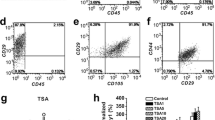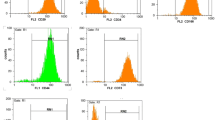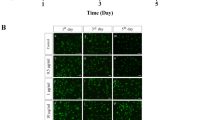Abstract
Purpose
Cell therapy has been proposed as an effective treatment method for bone regeneration using stem cells and osteogenic inducting mediators. In the present study, the ability of homeopathic remedy Symphytum officinale to induce osteogenic differentiation of rat bone marrow-derived mesenchymal stem cells (rat BM-MSCs) was studied
Methods
MSCs were isolated from the rat’s bone morrow. Cytotoxic effect of Symphytum on the MSCs was evaluated by MTT assay. The osteogenic induction ability of Symphytum has been assessed by alizarin red staining (ALZ) and quantitative alkaline phosphatase (ALP) activity assays and compared with the osteogenic standard medium.
Results
MTT assay results illustrated that Symphytum 200 C had a high cytotoxicity (to about 75.2 ± 3.12), so that lower potencies were used for the next experiments. Symphytum 6 C had the most color intensity in ALZ and ALP staining assays. Also, quantitative analyses of ALP activity revealed that Symphytum 6 C caused the most increase in the ALP activity up to 4.04 ± 0.34 and 7.86 ± 1.38 on day 7 and 21, respectively.
Conclusions
According to this finding, Symphytum could enhance osteogenic differentiation of MSCs and can be considered as a safe, low cost, and highly effective drug for bone regeneration.
Lay Summary
Cell therapy has been proposed as an effective treatment method for bone regeneration using stem cells and osteogenic inducting mediators. In the present study, the ability of homeopathic remedy Symphytum officinale to induce osteogenic differentiation of rat bone marrow-derived mesenchymal stem cells (rat BM-MSCs) was studied. The results illustrated that Symphytum 6 C had the most osteogenic induction effect compare with osteogenic standard medium. According to this finding, Symphytum officinale as a natural compound can significantly induce osteogenic differentiation of rat BM-MSCs. So, it could be considered as a safe and more cost-effective therapeutic agent for clinical treatment of bone disorders.

Graphical Abstract



Similar content being viewed by others
References
Arvidson K, Abdallah B, Applegate L, Baldini N, Cenni E, Gomez-Barrena E, et al. Bone regeneration and stem cells. J Cell Mol Med. 2011;15(4):718–46.
Amish Burn Study G, Kolacz NM, Jaroch MT, Bear ML, Hess RF. The effect of Burns & Wounds (B&W)/burdock leaf therapy on burn-injured Amish patients: a pilot study measuring pain levels, infection rates, and healing times. J Holist Nurs. 2014;32(4):327–40. https://doi.org/10.1177/0898010114525683.
Yun Y-R, Jang JH, Jeon E, Kang W, Lee S, Won J-E, et al. Administration of growth factors for bone regeneration. Regen Med. 2012;7(3):369–85.
Maniatopoulos C, Sodek J, Melcher A. Bone formation in vitro by stromal cells obtained from bone marrow of young adult rats. Cell Tissue Res. 1988;254(2):317–30.
Smajilagić A, Aljičević M, Redžić A, Filipović S, Lagumdžija AC. Rat bone marrow stem cells isolation and culture as a bone formative experimental system. Bosn J Basic Med Sci. 2013;13(1):27–30.
Azizi SA, Stokes D, Augelli BJ, DiGirolamo C, Prockop DJ. Engraftment and migration of human bone marrow stromal cells implanted in the brains of albino rats—similarities to astrocyte grafts. Proc Natl Acad Sci. 1998;95(7):3908–13.
Kolf CM, Cho E, Tuan RS. Mesenchymal stromal cells: biology of adult mesenchymal stem cells: regulation of niche, self-renewal and differentiation. Arthritis Res Ther. 2007;9(1):204. https://doi.org/10.1186/ar2116.
Jiang Y, Jahagirdar BN, Reinhardt RL, Schwartz RE, Keene CD, Ortiz-Gonzalez XR, et al. Pluripotency of mesenchymal stem cells derived from adult marrow. Nature. 2002;418(6893):41–9.
Pittenger MF, Mackay AM, Beck SC, Jaiswal RK, Douglas R, Mosca JD, et al. Multilineage potential of adult human mesenchymal stem cells. Science. 1999;284(5411):143–7.
Kim HK, Kim JH, Park DS, Park KS, Kang SS, Lee JS, et al. Osteogenesis induced by a bone forming peptide from the prodomain region of BMP-7. Biomaterials. 2012;33(29):7057–63.
Soares MM, Aloise A, Pellegrine A, Massako L. Adipose derived stem cell on the regeneration of irradiated mandibular submitted to distraction osteogenesis. Int J Oral Maxillofac Surg. 2013;42(10):1374.
Coelho M, Fernandes M. Human bone cell cultures in biocompatibility testing. Part II: effect of ascorbic acid, β-glycerophosphate and dexamethasone on osteoblastic differentiation. Biomaterials. 2000;21(11):1095–102.
Barna M, Kucera A, Hladicova M, Kucera M. Wound healing effects of a Symphytum herb extract cream (Symphytum x uplandicum NYMAN: ): results of a randomized, controlled double-blind study. Wien Med Wochenschr. 2007;157(21–22):569–74. https://doi.org/10.1007/s10354-007-0474-y.
Grube B, Grunwald J, Krug L, Staiger C. Efficacy of a comfrey root (Symphyti offic. radix) extract ointment in the treatment of patients with painful osteoarthritis of the knee: results of a double-blind, randomised, bicenter, placebo-controlled trial. Phytomedicine. 2007;14(1):2–10. https://doi.org/10.1016/j.phymed.2006.11.006.
Predel HG, Giannetti B, Koll R, Bulitta M, Staiger C. Efficacy of a comfrey root extract ointment in comparison to a diclofenac gel in the treatment of ankle distortions: results of an observer-blind, randomized, multicenter study. Phytomedicine. 2005;12(10):707–14. https://doi.org/10.1016/j.phymed.2005.06.001.
Sowa I, Paduch R, Strzemski M, Zielinska S, Rydzik-Strzemska E, Sawicki J, et al. Proliferative and antioxidant activity of Symphytum officinale root extract. Nat Prod Res. 2018;32(5):605–9. https://doi.org/10.1080/14786419.2017.1326492.
Salehi B, Sharopov F, Boyunegmez Tumer T, Ozleyen A, Rodriguez-Perez C, Ezzat SM, et al. Symphytum species: a comprehensive review on chemical composition, food applications and phytopharmacology. Molecules. 2019;24(12). https://doi.org/10.3390/molecules24122272.
Trifan A, Opitz SEW, Josuran R, Grubelnik A, Esslinger N, Peter S, et al. Is comfrey root more than toxic pyrrolizidine alkaloids? Salvianolic acids among antioxidant polyphenols in comfrey (Symphytum officinale L.) roots. Food Chem Toxicol. 2018;112:178–87. https://doi.org/10.1016/j.fct.2017.12.051.
Smith DB, Jacobson BH. Effect of a blend of comfrey root extract (Symphytum officinale L.) and tannic acid creams in the treatment of osteoarthritis of the knee: randomized, placebo-controlled, double-blind, multiclinical trials. J Chiropr Med. 2011;10(3):147–56. https://doi.org/10.1016/j.jcm.2011.01.003.
Huang W, Yang S, Shao J, Li Y-P. Signaling and transcriptional regulation in osteoblast commitment and differentiation. Front Biosci. 2007;12:3068.
Moon JS, Kim SH, Oh SH, Jeong YW, Kang JH, Park JC, et al. Relaxin augments BMP-2–induced osteoblast differentiation and bone formation. J Bone Miner Res. 2014;29(7):1586–96.
Betz JM, Eppley RM, Taylor WC, Andrzejewski D. Determination of pyrrolizidine alkaloids in commercial comfrey products (Symphytum sp.). J Pharm Sci. 1994;83(5):649–53.
Mattocks AR. Toxic pyrrolizidine alkaloids in comfrey. Lancet. 1980;2(8204):1136–7.
Kruse LH, Stegemann T, Sievert C, Ober D. Identification of a second site of pyrrolizidine alkaloid biosynthesis in comfrey to boost plant defense in floral stage(). Plant Physiol. 2017;174(1):47–55. https://doi.org/10.1104/pp.17.00265.
Brown AW, Stegelmeier BL, Colegate SM, Gardner DR, Panter KE, Knoppel EL, et al. The comparative toxicity of a reduced, crude comfrey (Symphytum officinale) alkaloid extract and the pure, comfrey-derived pyrrolizidine alkaloids, lycopsamine and intermedine in chicks (Gallus gallus domesticus). J Appl Toxicol. 2016;36(5):716–25. https://doi.org/10.1002/jat.3205.
Mei N, Guo L, Fu PP, Fuscoe JC, Luan Y, Chen T. Metabolism, genotoxicity, and carcinogenicity of comfrey. J Toxicol Environ Health Part B Crit Rev. 2010;13(7–8):509–26. https://doi.org/10.1080/10937404.2010.509013.
Rode D. Comfrey toxicity revisited. Trends Pharmacol Sci. 2002;23(11):497–9.
Vithayathil MK, Edwards M. Comfrey herbal remedy causing second-degree heart block: do not be outfoxed by digitalis. BMJ Case Rep. 2016;2016. https://doi.org/10.1136/bcr-2016-216995.
Clausen J, Moss S, Tournier A, Lüdtke R, Albrecht H. CORE-Hom: a powerful and exhaustive database of clinical trials in homeopathy. Homeopathy. 2014;103(4):219–23.
Angell M, Kassirer JP. Alternative medicine-the risks of untested and unregulated remedies. N Engl J Med. 1998;339:839–40.
Khuda-Bukhsh AR. Towards understanding molecular mechanisms of action of homeopathic drugs: an overview. Mol Cell Biochem. 2003;253(1):339–45.
Koley M, Saha S, Ghosh S. A double-blind randomized placebo-controlled feasibility study evaluating individualized homeopathy in managing pain of knee osteoarthritis. J Evid Based Complementary Altern Med. 2015;20(3):186–91.
Tsintzas D, Vithoulkas G. Fracture treatment with the aid of the homeopathic remedy Symphytum officinale. A report of four cases. Clin Case Rep Rev. 2016;2(5):422–4. https://doi.org/10.15761/CCRR.1000234.
Spin-Neto R, Belluci MM, Sakakura CE, Scaf G, Pepato MT, Marcantonio E Jr. Homeopathic Symphytum officinale increases removal torque and radiographic bone density around titanium implants in rats. Homeopathy. 2010;99(4):249–54. https://doi.org/10.1016/j.homp.2010.08.002.
Kalalinia F, Ghasim H, Amel Farzad S, Pishavar E, Ramezani M, Hashemi M. Comparison of the effect of crocin and crocetin, two major compounds extracted from saffron, on osteogenic differentiation of mesenchymal stem cells. Life Sci. 2018;208:262–7. https://doi.org/10.1016/j.lfs.2018.07.043.
Zhang L, Chan C. Isolation and enrichment of rat mesenchymal stem cells (MSCs) and separation of single-colony derived MSCs. J Vis Exp. 2010;37. https://doi.org/10.3791/1852.
Jaiswal N, Haynesworth SE, Caplan AI, Bruder SP. Osteogenic differentiation of purified, culture-expanded human mesenchymal stem cells in vitro. J Cell Biochem. 1997;64(2):295–312.
Toosi S, Naderi-Meshkin H, Kalalinia F, Pievandi MT, Hosseinkhani H, Bahrami AR, et al. Long bone mesenchymal stem cells (Lb-MSCs): clinically reliable cells for osteo-diseases. Cell Tissue Bank. 2017;18(4):489–500. https://doi.org/10.1007/s10561-017-9652-3.
Toosi S, Naderi-Meshkin H, Kalalinia F, Peivandi MT, Hossein Khani H, Bahrami AR, et al. Comparative characteristics of mesenchymal stem cells derived from reamer-irrigator-aspirator, iliac crest bone marrow, and adipose tissue. Cell Mol Biol (Noisy-le-grand). 2016;62(10):68–74.
Hall BK. Bones and cartilage: developmental and evolutionary skeletal biology. Academic Press; 2005.
Arvidson K, Abdallah BM, Applegate LA, Baldini N, Cenni E, Gomez-Barrena E, et al. Bone regeneration and stem cells. J Cell Mol Med. 2011;15(4):718–46. https://doi.org/10.1111/j.1582-4934.2010.01224.x.
Madeddu P. Stem cell therapy for cardiovascular regeneration: the beginning or the end of all hearts' hopes. Pharmacol Ther. 2011;129(1):1–2. https://doi.org/10.1016/j.pharmthera.2010.09.006.
Yun YR, Jang JH, Jeon E, Kang W, Lee S, Won JE, et al. Administration of growth factors for bone regeneration. Regen Med. 2012;7(3):369–85. https://doi.org/10.2217/rme.12.1.
Singh V. Medicinal plants and bone healing. Natl J Maxillofac Surg. 2017;8(1):4–11. https://doi.org/10.4103/0975-5950.208972.
Clausen J, van Wijk R, Albrecht H. Infection models in basic research on homeopathy. Homeopathy. 2010;99(4):263–70.
Datta HK, Ng WF, Walker JA, Tuck SP, Varanasi SS. The cell biology of bone metabolism. J Clin Pathol. 2008;61(5):577–87. https://doi.org/10.1136/jcp.2007.048868.
Zhang C. Transcriptional regulation of bone formation by the osteoblast-specific transcription factor Osx. J Orthop Surg Res. 2010;5:37. https://doi.org/10.1186/1749-799X-5-37.
Frost R, MacPherson H, O'Meara S. A critical scoping review of external uses of comfrey (Symphytum spp.). Complement Ther Med. 2013;21(6):724–45. https://doi.org/10.1016/j.ctim.2013.09.009.
Kucera M, Kalal J, Polesna Z. Effects of Symphytum ointment on muscular symptoms and functional locomotor disturbances. Adv Ther. 2000;17(4):204–10. https://doi.org/10.1007/BF02850297.
Araujo LU, Reis PG, Barbosa LC, Saude-Guimaraes DA, Grabe-Guimaraes A, Mosqueira VC, et al. In vivo wound healing effects of Symphytum officinale L. leaves extract in different topical formulations. Die Pharmazie. 2012;67(4):355–60.
Oberbaum M, Yakovlev E, Kaufman D, Shoshan S. Effect of Arnica Montana and Symphytum officinalis on bone healing in Guinea pigs. Homeopath J. 1994;83:90.
Acknowledgments
The authors are thankful to the Mashhad University of Medical Sciences, Iran, for approval and financial support of this project with the grant number 911297. The results presented in this article are the results of the master thesis of Mrs. Shahla Vaezi.
Funding
The study was financially supported by the Mashhad University of Medical Sciences, Iran, with the grant number 911297.
Author information
Authors and Affiliations
Corresponding author
Ethics declarations
Conflict of Interest
The authors declare that they have no conflicts of interests.
Additional information
Publisher’s Note
Springer Nature remains neutral with regard to jurisdictional claims in published maps and institutional affiliations.
Description of future works
In the future works, the effects of Symphytum officinale on the osteogenic differentiation will be studied more on the molecular level (specific osteogenic gene expression at mRNA and protein level). Also, the effectiveness of Symphytum officinale on the bone generation will be studied in the clinical trial studies.
Rights and permissions
About this article
Cite this article
Vaezi, S., Haghighi, H.M., Farzad, S.A. et al. Bone Regeneration by Homeopathic Symphytum officinale. Regen. Eng. Transl. Med. 7, 548–555 (2021). https://doi.org/10.1007/s40883-020-00181-z
Received:
Revised:
Accepted:
Published:
Issue Date:
DOI: https://doi.org/10.1007/s40883-020-00181-z




